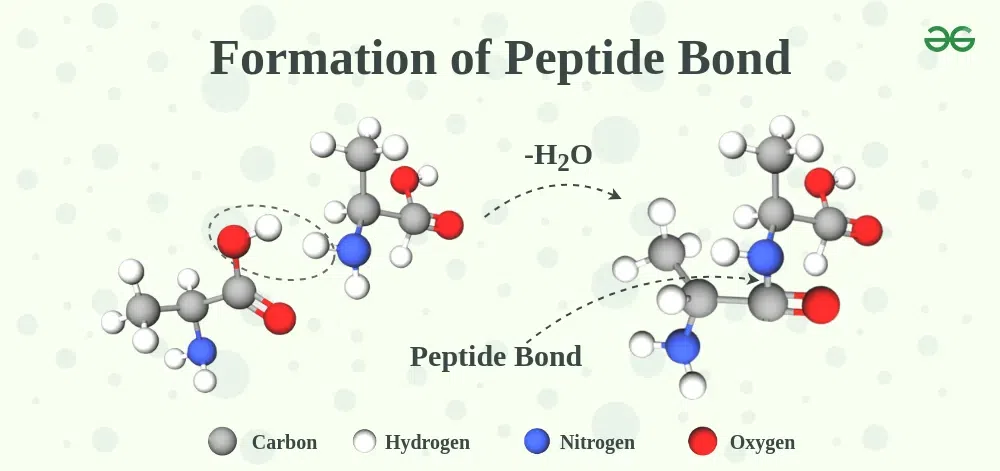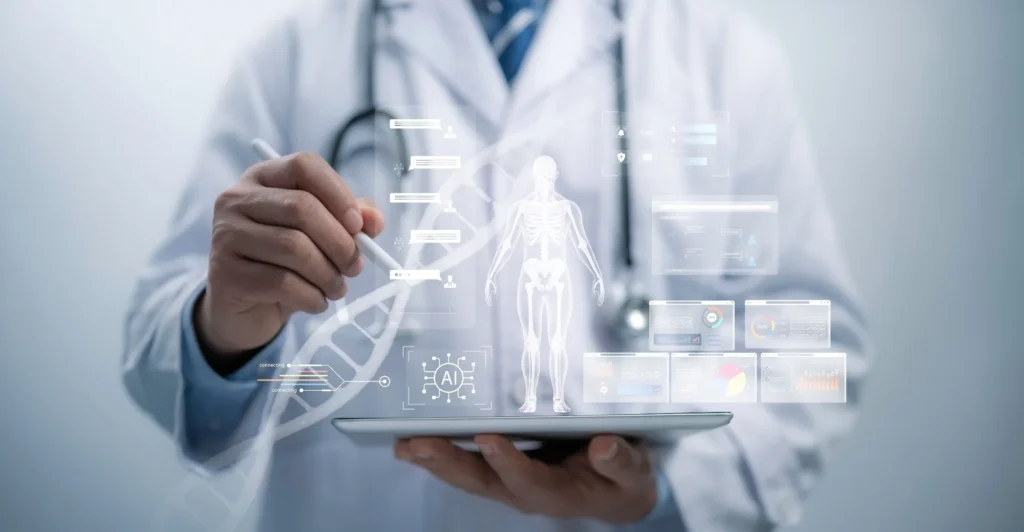
Key Highlights About Peptides
- Peptides are short chains of amino acids, which are the fundamental building blocks of proteins.
- They play crucial roles in human health, acting as messengers that regulate various biological functions.
- Peptides are different from proteins primarily in size, which impacts their structure and function.
- Peptide therapy is an emerging field with applications ranging from skin health to muscle growth.
- While offering many potential benefits, it’s essential to approach peptide use safely under professional guidance.
- Certain peptides can improve skin health by stimulating collagen production and enhancing skin elasticity.
What Are Peptides? A Beginner’s Guide Explained
Welcome to the fascinating world of peptides! You may have heard this term in discussions about alternative medicine, skincare, or fitness. Peptides are becoming increasingly popular for their potential therapeutic benefits. These small but mighty molecules are essentially short chains of amino acids, the very building blocks that make up proteins in your body. In this guide, we’ll explore what peptides are, how they function, and their growing role in health and wellness. Let’s get started on your journey to understanding these vital compounds.
What Are Peptides?
If you’re asking, “What are peptides?” this beginner’s guide is for you. Simply put, peptides are small molecules made from short chains of amino acids. Think of them as the smaller cousins of proteins. They occur naturally in your body and are essential for countless biological processes.
The key difference between peptides and proteins lies in their length; peptides consist of 2 to 50 amino acids, while proteins are made of longer, more complex chains. This structural difference dictates their unique roles and functions within the human body.
Definition and Basic Structure of Peptides
At their core, peptides are defined as short chains of amino acids linked together by peptide bonds. These small molecules are fundamental to life, typically comprising between two and 50 amino acids. Because of their smaller size, they can be more easily absorbed by the body compared to larger protein molecules.
According to the National Human Genome Research Institute, every peptide is characterized by a specific structure. This includes a central carbon atom, an amino group, a carboxyl group, and a unique side chain. It is this side chain that distinguishes one amino acid from another.
The specific sequence in which these amino acids are arranged gives each peptide its unique structural characteristics and, consequently, its distinct function. This precise arrangement is what allows peptides to act as highly targeted signaling molecules within the body, influencing everything from hormone production to cellular repair.

Peptides vs. Proteins: Key Differences Explained
While both peptides and proteins are made from the same building blocks—amino acids—their primary difference is size. Peptides are significantly smaller, consisting of short chains of fewer than 50 amino acids. Proteins, on the other hand, are large, complex molecules composed of one or more polypeptide chains, often containing hundreds or thousands of amino acids.
This size difference directly impacts their structure and function. Proteins have intricate, three-dimensional structures that allow them to perform a vast array of tasks, such as acting as enzymes or providing structural support to cells. Their complexity enables them to handle diverse and demanding biological roles.
In contrast, peptides have simpler structures due to their shorter chains. This simplicity makes them ideal for acting as signaling molecules or hormone precursors. Their smaller size allows them to move through the body and interact with cell receptors more easily, making them effective communicators in biological processes.
Why Peptides Matter in Biochemistry and Health
Peptides are incredibly important in biochemistry and human health because they act as precise communicators within your body. Think of them as messengers that bind to specific receptors on the surface of cells. This interaction initiates a chain of events inside the cell, leading to a desired biological response, such as healing or reducing inflammation.
Their ability to target specific cells and trigger precise actions gives them immense therapeutic potential. Understanding how these molecules work opens the door to new treatments for a wide range of health conditions. Let’s explore the specific biological functions peptides perform and their importance to your overall health.
Biological Functions of Peptides
Peptides are involved in a remarkable number of biological functions throughout the human body. They serve as critical signaling molecules, transmitting information between cells, tissues, and organs. Many essential hormones and neurotransmitters are, in fact, peptides that regulate vital processes.
For example, peptide hormones like insulin are responsible for regulating your blood sugar levels, while others like oxytocin play a role in social bonding. In the nervous system, peptide neurotransmitters help modulate pain perception and mood. The versatility of peptides allows them to influence a wide spectrum of physiological activities.
Furthermore, some peptides are integral to the immune system. Known as antimicrobial peptides, they act as part of the body’s innate defense against harmful bacteria, fungi, and viruses. These diverse roles highlight just how essential the proper function of peptides is for maintaining a healthy body.
Importance of Peptides in Human Health
The significance of peptides in human health cannot be overstated. They are fundamental players in maintaining balance and function across multiple systems. One of their most critical roles is in supporting immune function. Peptides like thymosin alpha-1, for instance, can boost the body’s immune response, helping you fend off infections.
Peptides are also crucial for metabolic regulation. As peptide hormones, they help manage processes like blood sugar control. Insulin is a well-known example that helps transport glucose from your bloodstream into cells for energy. Without it, managing blood sugar would be impossible.
Beyond these functions, peptides are involved in tissue repair, inflammation control, and even brain health. Their ability to send specific signals makes them valuable for promoting healing and maintaining overall wellness. The targeted nature of peptides is what makes them so promising for various therapeutic applications in modern medicine.
Types of Peptides and Their Roles
Did you know there are different types of peptides, each with a specialized job? These can be broadly categorized based on their origin and function. For example, endogenous peptides are produced naturally inside your body, while exogenous peptides come from external sources like food or supplements.
Bioactive peptides, in particular, have a direct impact on bodily functions once they are absorbed. Understanding these different categories helps clarify how peptides can be used for targeted health benefits. Below, we’ll look at specific types, including signaling peptides and those used for therapeutic purposes.
Signaling Peptides
Signaling peptides are like the body’s postal service, delivering crucial messages that regulate bodily functions. These peptides, which include many hormones and neurotransmitters, work by binding to specific receptors on the surface of cells. This binding action triggers a particular response within the cell.
A great example is their role in hormone production. When a signaling peptide binds to a receptor on an endocrine gland, it can stimulate or inhibit the release of a hormone. This mechanism is central to regulating everything from your metabolism to your stress response.
Similarly, these peptides are vital for a proper immune response. They can signal immune cells to activate, helping the body fight off pathogens or reduce inflammation. By acting as precise messengers, signaling peptides ensure that complex biological processes are carried out correctly and efficiently.
Therapeutic and Cosmetic Peptides
Beyond their natural roles, peptides have been harnessed for therapeutic and cosmetic purposes through peptide synthesis. In skincare, cosmetic peptides have become star ingredients. Certain peptides, known as collagen peptides, can signal skin cells to produce more collagen, the protein responsible for skin’s firmness and elasticity.
For example, palmitoyl pentapeptide-4 is a popular ingredient in anti-aging creams because of its ability to stimulate collagen and repair skin. These peptides can help improve skin texture, reduce the appearance of wrinkles, and promote a more youthful look.
In the therapeutic realm, peptides are developed as drugs to treat various conditions. Their ability to target specific pathways with fewer side effects than traditional medications makes them highly attractive. From managing diabetes to promoting wound healing, therapeutic peptides offer innovative solutions for modern healthcare challenges.
Common Medical and Health Uses of Peptides
The application of peptides in medicine and health is broad and continues to expand. Peptide therapy is used to address a variety of health goals, from managing a specific medical condition to enhancing overall wellness. Common uses include promoting muscle growth, aiding in weight loss, supporting immune function, and accelerating wound healing.
Because peptides can be designed to perform very specific actions, they offer a targeted approach to treatment. It is crucial to consult with a healthcare provider to determine if peptide therapy is right for you. Now, let’s examine peptide therapy in medicine and its popular use for skin health.

Peptide Therapy in Modern Medicine
Peptide therapy represents a cutting-edge approach in modern medicine, utilizing specific peptides to treat various health conditions. This therapy often involves the targeted drug administration of peptides to achieve a desired physiological outcome, commonly through injections, nasal sprays, or oral tablets.
One prominent category of peptides used in therapy is growth hormone secretagogues. These include peptides like GHRPs (Growth Hormone-Releasing Peptides) and CJC-1295. Their primary function is to stimulate the pituitary gland to release more of the body’s own human growth hormone (HGH).
This increase in HGH can lead to significant benefits, such as increased muscle mass, enhanced fat loss, and improved bone density. Because these peptides encourage natural hormone production rather than introducing synthetic hormones, they are often considered a more balanced approach to hormonal optimization.
Peptides for Skin Health and Appearance
Peptides have become a cornerstone of advanced skincare, prized for their ability to visibly improve skin health. Many popular skincare products now feature collagen peptides, which are designed to rejuvenate the skin from within. These peptides work by signaling your skin to ramp up its production of collagen.
As you age, natural collagen production declines, leading to wrinkles and loss of firmness. By applying peptides topically, you can help counteract this process. Peptides like Matrixyl and Argireline are well-known for their effectiveness in reducing the appearance of fine lines and improving skin elasticity.
Consistent use of skincare products containing these peptides can lead to a smoother, firmer, and more youthful-looking complexion. They offer a non-invasive way to support your skin’s structure and combat the visible signs of aging, making them a valuable addition to any anti-aging routine.
Beginner’s Guide: How to Start with Peptides
Starting with peptides can feel exciting, but it’s important to approach it with knowledge and caution. This beginner’s guide is designed to help you navigate the initial steps safely. The first and most critical step is to consult with a qualified healthcare provider. They can assess your health goals and medical history to determine if peptide therapy is a suitable and safe option for you. A professional can guide you toward the right peptide supplements or therapy plan.
Before you begin, gathering the right information is key. Research the specific peptides you are interested in and understand their intended effects and potential side effects. Look for reputable resources and be wary of anecdotal claims. Proper preparation and understanding the safety essentials will ensure you have a positive and responsible experience with peptide therapy.
What You’ll Need to Begin—Equipment, Resources, and Safety Essentials
When you’re ready to start your journey with peptide supplements or therapy, having the right tools and knowledge is crucial. The most important resource is a qualified healthcare provider who can offer personalized advice and monitor your progress. They are your best guide for navigating this process safely.
Depending on the type of peptide and its administration route, you may need specific equipment. For injectable peptides, this would include sterile syringes, alcohol swabs, and a safe sharps disposal container. Your provider will give you detailed instructions on how to use these items correctly.
Beyond equipment, focusing on safety essentials and reliable resources will set you up for success. Here’s what you should prioritize:
- A consultation with a healthcare provider: This is non-negotiable for assessing suitability and getting a prescription if needed.
- High-quality peptides: Source your peptides from a reputable supplier that provides third-party testing for purity and quality.
- Clear dosage instructions: Understand the correct dosage, frequency, and administration method for your specific peptide.
- Knowledge of potential side effects: Be informed about possible adverse reactions and know when to contact your provider.
Step-by-Step Guide to Trying Peptides Safely
To ensure your experience with peptide therapy is both safe and effective, following a structured approach is essential. This step-by-step guide will help you begin responsibly. The journey starts with thorough research and moves toward careful usage and monitoring, always prioritizing your well-being. By taking a methodical approach, you can minimize risks and better understand how your body responds.
Remember, this process isn’t a race. Each step is designed to build your knowledge and confidence while keeping safety at the forefront. Whether you’re exploring peptides for general wellness or to address specific health conditions, a cautious and informed start is the best way to achieve your desired outcomes. Let’s break down the first step: choosing the right peptide for your goals.
Step 1: Research and Choose the Right Peptide
The first step in your peptide journey is to conduct thorough research. With many different peptides available, each designed for a specific purpose, it’s vital to find the one that aligns with your health goals. Are you looking to improve skin health, support muscle recovery, or enhance immune function? Your objective will determine which peptide is most suitable.
Each peptide has a specific sequence of amino acids that dictates its function. For example, BPC-157 is known for its tissue-healing properties, while CJC-1295 is used to stimulate growth hormone release. Understanding these distinctions is crucial for making an informed choice.
Consulting reliable sources and discussing your options with a healthcare provider will help you narrow down the choices. They can explain how certain peptide hormones or signaling molecules work and help you select a peptide that is both effective and appropriate for your individual needs.
Step 2: Understand Dosage, Usage, and Application
Once you’ve chosen a peptide, the next critical step is to understand its proper dosage and application. Incorrect dosage is one of the primary reasons for adverse reactions, so this step should never be rushed. Your healthcare provider will give you precise instructions, but it’s your responsibility to follow them carefully.
The method of drug administration varies depending on the peptide. Some are available as topical creams, others as nasal sprays, and many are administered via subcutaneous injection. Each method has a different absorption rate and protocol.
It’s essential to learn the correct technique for the chosen application to ensure efficacy and safety. For example, if using injections, you must learn how to handle the equipment sterilely. Below is a table outlining common administration routes.
| Administration Route | Description | Common Peptides |
|---|---|---|
| Subcutaneous Injection | Injected into the fat layer under the skin. | BPC-157, CJC-1295, Ipamorelin |
| Topical Cream/Serum | Applied directly to the skin. | GHK-Cu, Collagen Peptides |
| Nasal Spray | Absorbed through the nasal mucosa. | Semax, Selank, Melanotan II |
| Oral Tablet/Capsule | Swallowed, but less common due to degradation by stomach acid. | BPC-157 (some forms) |
Step 3: Monitor and Track Effects Responsibly
After you begin using a peptide, it is crucial to monitor and track its effects responsibly. Paying close attention to how your body responds will help you and your healthcare provider determine if the therapy is working as intended. Keep a simple journal to log your dosage, the time of administration, and any changes you notice.
This tracking should include both positive effects and any potential side effects. Are you seeing improvements related to your health goals? Are you experiencing any unusual symptoms like fatigue, redness at the injection site, or headaches? Documenting everything provides valuable data.
If you have pre-existing health conditions, monitoring becomes even more important. Regular check-ins with your provider are essential to review your progress and make any necessary adjustments to your protocol. This responsible approach ensures you can address any issues promptly and optimize the benefits of your peptide therapy.
Safety, Side Effects, and Considerations for Beginners
Navigating the world of peptides as a beginner requires a strong focus on safety. While peptides are generally well-tolerated because they are natural to the body, they are not without risks. Understanding the potential side effects and safety essentials is key to a positive experience.
It’s important to be aware of possible adverse reactions, especially if you have an underlying medical condition. The following sections will provide more detail on the potential risks and, more importantly, how you can minimize them for a safe and effective journey.
Potential Risks and Side Effects
While peptide therapy offers many benefits, it’s important to be aware of potential risks and side effects. Most side effects are mild and temporary, but being informed helps you recognize them. Common adverse reactions include pain, redness, itching, or swelling at the injection site. These symptoms typically resolve on their own within a short time.
In some cases, users may experience other unwanted side effects such as increased water retention, fatigue, or headaches, particularly when first starting therapy. Certain peptides that influence hormones, like growth hormone secretagogues, could potentially lead to hormonal imbalances if not used according to proper guidance.
It’s also possible to have an allergic reaction to a peptide, with symptoms like swelling or difficulty breathing, although this is rare. Discussing your health conditions and any allergies with your healthcare provider before starting is a critical step to mitigate these risks.
How to Minimize Risks When Using Peptides
Minimizing risks when using peptides is achievable with a cautious and informed approach. The most effective way to ensure your safety is to work closely with a professional. Following their guidance on dosage and administration can help you avoid many common adverse reactions.
Sourcing high-quality products is another cornerstone of the safety essentials. Ensure your peptides come from a reputable supplier that provides third-party lab testing results. This confirms the purity and concentration of the product, reducing the risk of contamination or incorrect dosing.
To further minimize risks, consider these practical steps:
- Always consult a healthcare provider: Never start peptide therapy without professional medical advice.
- Start with a low dose: Begin with the lowest effective dose to see how your body reacts before considering an increase.
- Follow sterile procedures: If injecting, always use sterile needles and proper techniques to prevent infection.
- Listen to your body: Pay attention to any unusual symptoms and report them to your provider immediately.
- Purchase from trusted sources: Avoid unregulated websites and stick to suppliers who value transparency and quality control.
Conclusion
In conclusion, understanding peptides is essential for anyone interested in enhancing their health and wellness journey. From their basic structure to their critical roles in biochemistry and human health, peptides offer a multitude of benefits, especially when used thoughtfully. By exploring various types of peptides—from signaling to therapeutic—you can find options that align with your specific needs. As you begin your peptide journey, remember to prioritize safety by researching thoroughly and monitoring your progress. If you’re intrigued and want to dive deeper into the world of peptides, don’t hesitate to reach out for a free consultation with our experts at Prime Peptides Ltd. Your path to a healthier you can start today!
Incorporating Peptides into Your Health and Wellness Routine
Integrating peptides into your health and wellness routine can be a proactive way to support your body’s functions. Whether through targeted peptide supplements or specialized therapies, they can help you achieve specific goals like enhanced immune support, better skin health, or improved recovery. The key is to see them as a component of a holistic lifestyle that includes a balanced diet, regular exercise, and adequate rest.
For example, someone looking to improve their athletic performance might use peptides that support muscle repair, while another person might use cosmetic peptides in their skincare regimen. Because peptides work by interacting with specific receptors, they offer a targeted way to influence biological processes. Always remember to begin this journey with guidance from a healthcare professional who can help tailor a plan that aligns with your individual health needs and ensures you proceed safely.
Potential Risks and Side Effects of Peptide Use
While the benefits of peptides are compelling, understanding the potential risks and side effects is just as important. Unwanted side effects can occur, particularly if peptides are used without proper medical supervision. The most common adverse reactions are often localized, such as redness, swelling, or discomfort at the injection site. Some individuals may also experience temporary symptoms like headaches, fatigue, or nausea as their body adjusts.
For individuals with a pre-existing medical condition, the risks can be more significant. Peptides that influence hormones or blood pressure could exacerbate certain health issues if not managed correctly. This is why a thorough evaluation by a healthcare provider is essential before starting any peptide regimen. They can assess your health status and help you avoid potential adverse reactions, ensuring your experience is as safe as possible.
Frequently Asked Questions
Are peptides safe for beginners to use?
Peptides can be safe for beginners, but only when used under the guidance of a qualified healthcare provider. Adhering to safety essentials, understanding potential side effects, and starting with a proper dosage are crucial. A professional can assess your medical condition to minimize the risk of adverse reactions.
Can peptides help with muscle growth or recovery?
Yes, certain peptides are known to support muscle growth and tissue repair. Peptide therapy involving growth hormone-releasing peptides can stimulate your body’s natural production of growth hormone, which is essential for building muscle mass and accelerating recovery after exercise or injury, making them popular for wound healing and performance enhancement.
What should I know before starting peptide therapy?
Before starting peptide therapy, you must consult a healthcare provider to discuss your medical condition and goals. It is essential to understand the specific peptide you’ll be using, the correct dosage, and potential adverse reactions. Sourcing high-quality products and learning the proper administration technique are also critical first steps.
How do peptides improve skin health?
Peptides improve skin health primarily by stimulating collagen production. Many skincare products contain collagen peptides that signal skin cells to create more of this structural protein. This helps reduce the appearance of fine lines, improve skin elasticity, and promote a firmer, more youthful complexion over time.
https://pmc.ncbi.nlm.nih.gov/articles/PMC8836030
